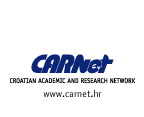

|
||
 |
||
 |
||


| Authors: Melita Valentić -Peruzović, Davor Illeš, Iva Alajbeg, Ivica Pelivan, School of Dental Medicine, Croatia | | Full paper | Presentation
| |
Abstract
Dentistry is a field in biomedicine which usually requires presence of a therapist for diagnosis as well as for therapy. Therefore it seems that there is no solid base for application of IT for distance diagnosis and therapy procedures. Modern dental units, which are currently present on a market include intraoral cameras, which are capable of producing high quality intraoral images and real time video signal capture. Currently these cameras are being us ed to provide better understanding of dental procedures and their results. There are many projects which utilize such technology in many specialty branches in dentistry. Protocols developed for specialists of orthodontics which can provide a checkup appointments for a patients undergoing orthodontic therapy are being developed at Institute of Learning and Research Technology, University of Bristol, UK. and University of California, School of Dentistry, USA.; for specialists of periodontology Web-based intervention system for periodontal health is being developed at Department of Preventive Dentistry, Graduate School of Dentistry, Osaka University, Suita, Japan; in field of preventive and restorative dentistry there are continuous efforts at Department of Pediatric Dentistry, University of Texas-Houston Health Science Center, Huston, USA. Protocols of exchanging digitalized dental information and multimedia materials in field of general dentistry are being developed at York Health Economics Consortium, University of York, UK., Dental Health Services Research Unit, University of Dundee, Scotland, UK and School of Dentistry, University of Louisville, Louisville USA.
Radiographic image is an essential tool when diagnosing various conditions in dentistry. Digital X-ray equipment is becoming a standard because of the simplicity, lower level of radiation and new diagnostic abilities.
There is a number of computer aided diagnostic procedures used primarily by specialists of various dental disciplines: axiography – procedure where movements of a lower jaw and temporomandibular joint are transferred to the computer and then analyzed; electromyography (EMG)– procedure for recording electric potentials of the masticatory muscles and analysis of their function; optoelectronic analysis – where picture or 3D model of human face (and stomatognatic system) is digitalized and analyzed from various aspects.
Our efforts at the School of Dental Medicine University of Zagreb were directed towards developing a platform for communication between distant dental offices and center - School of Dental Medicine in the field of Prosthetic Dentistry and Gnathology with special emphasis on functional diagnostics using computer aided diagnostic procedures– EMG and axiography. Programs utilized in development of protocols for this platform are widely used and simple to use for users with average computer skills. Two paths of communications were developed: first (axis one) utilizing communication between dental offices in various parts of Croatia and second (axis two) for communication with referent centers for various dental specialty around the world. Hardware used included digital photo & video camera specially adapted for usage in dentistry, intraoral camera, scanner with ability of scanning transparencies, and experimental system for acquisition of audio and EMG (electromyographic) signal.
Software used included Windows XP Professional operating system and integral parts of that system – Net meeting and IIS server.
Platform was developed and tested in field of Prosthetic Dentistry in cooperation with University of Rijeka, School of Medicine, Dental Division, Rijeka, Croatia. Two cases were considered: First – simulation of a patient in general dental practice with symptoms characteristic for temporomandibular disorders (TMD). Two teams of specialists in the field were involved. Five patients were examined, their medical histories were provided to a second team by putting relevant information, X-ray images on appropriate password protected web site. Another examination was performed by using Netmeeting software and both intraoral and extraoral camera. Coincidence of diagnosis was noted. Second trial was conducted by providing a second team in real time insight in EMG recording and axiography recording procedures. Software utilized was again Windows Netmeeting.
Early results suggested that there is great feasibility and cost effectiveness in utilizing axis one platform. That platform proved to be efficient, cost effective, and highly beneficial for quality of dental care. Standardization of protocols and software support will be necessary for further improvement in benefits and efficiency. Platform developed for exchange of information between “centres of excellence” (axis 2) revealed certain problems. Because of special and sophisticated hardware utilized in diagnostic procedures, special software should be utilized and developed. Another problem of this system is standardization of data formats and diagnostic signs and symptoms which have to be addressed in dental science & research community.
Also, some new efforts are made in the field of Practice Based Dentistry (PBD) to supply advanced students and newly graduated dentists with the diagnostic specialties of some unusual cases, offering through teledentistry insight in dental diagnosis, prognosis and therapy.